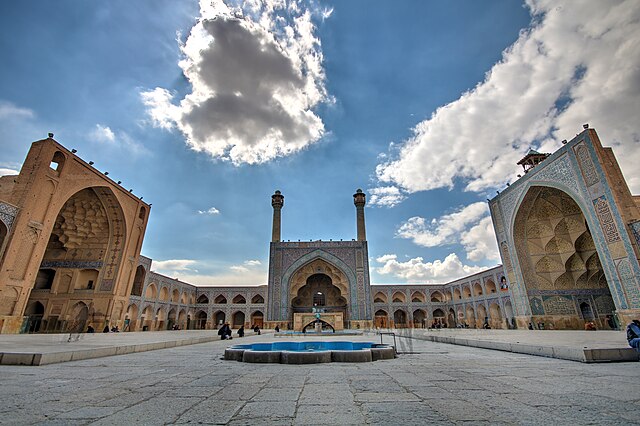Table of Contents
The Jameh Mosque of Isfahan, also known as Isfahan Old Friday Mosque, is a stunning ancient mosque in the heart of Isfahan city. It’s been around since the 8th century, with lots of building and rebuilding over the years. This mosque is really special—it’s a UNESCO World Heritage Site! People say it’s so old that one of its pillars might have been made by a powerful leader long ago. Before it was a mosque, it was a place of worship for a different religion called Zoroastrianism.
Walking around the mosque feels like stepping back in time. There are so many cool details to see, like the big marketplace nearby and the fancy pillars inside. The way the sunlight shines through the windows makes pretty patterns on the walls. And the mosque’s design, with its four gateways all lined up, looks really balanced and peaceful. This Great Mosque of Isfahan isn’t just a building—it’s a special place where history and culture come alive, showing us how creative and amazing people can be.
Jameh Mosque of Isfahan History
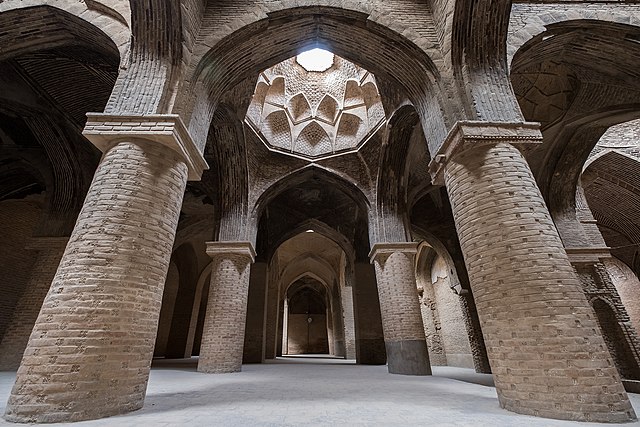
Let’s take a stroll through the captivating story of the Jameh Mosque of Isfahan. Built in the 2nd century AH, this grand monument reflects the city’s past. Initially constructed in 156 AH, the mosque was small, fitting the population of Isfahan back then. But in 226 AH, it got a makeover with wooden columns, changing its look for centuries to come.
During the Seljuk era, the mosque underwent significant changes. Architects introduced a fresh style with four iwans, setting it apart from traditional mosques. However, in 515 AH, disaster struck when the mosque was set ablaze by the Ismailis. Yet, through it all, the mosque endured, thanks to the efforts of different ruling dynasties. From the Ilkhanids to the Qajars, each dynasty played a part in rebuilding and preserving this iconic landmark.
Jameh Mosque of Isfahan Architecture
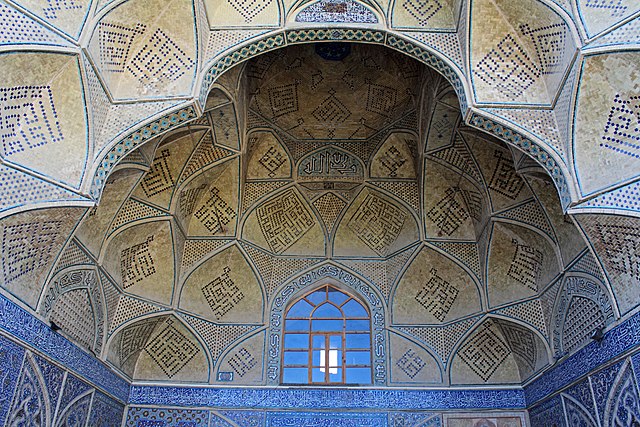
The Jameh Mosque of Isfahan is an incredible old building in Iran, showcasing the talent of skilled craftsmen and architects from different times. Its design, with four main parts, fits perfectly into the old city and has many doors and passages. Inside, you’ll find several large hallways called iwans, which are typical of Iranian mosques.
Decorations in the mosque, like stuccos, tiles, and muqarnas, make it look stunning. The domes of the mosque started as squares but changed over time to become octagonal, hexadecagonal, and then circular.
On the walls, you can see names of kings like Shah Abbas Safavi and Malikshah Seljuki, as well as other important people like ministers. The mosque is mostly made of bricks, with some areas using rough bricks.
The way the bricks are used, with columns split into different sections and special designs on the domes, makes the mosque’s architecture remarkable. Yusef Isfahani is known for creating some of the dome’s designs in the Jameh Mosque of Isfahan.
The Ceiling
Take a stroll through the southern part of the Jameh Mosque of Isfahan, and you’ll find a piece of the past waiting to be discovered. Built between 465 and 485 AH (1072 to 1092 AD), the dome and its forty columns tell a tale of craftsmanship from centuries ago. Made during Malikshah Seljuk’s rule and under Khwaja Nizam al-Mulk’s guidance, this structure stands out as a rare example of Seljuk-style architecture.
The dome, surrounded by rows of columns, reflects the skilled work of its builders. It’s like stepping back in time, seeing how people created such beautiful things long ago. As sunlight shines through the dome’s patterns, you can’t help but appreciate the history and effort behind this stunning piece of architecture.
The Entrance
Step into the Friday Mosque Isfahan, and you’ll find yourself surrounded by a network of entrances and paths that tell the story of its connection to the city’s past. Shaped like a rectangle, this mosque boasts ten entrances, welcoming visitors from all sides. Inside, you’ll discover iwans, minarets, and even a library, adding to its charm.
During the Qajar era, when Fath-Ali Shah ruled, parts of the mosque, like the eastern entrance and the mausoleum of Allameh Majlisi in the northwest, were restored to keep its history alive. The southern entrance gate is especially striking, with beautiful writings from Surah Aal-e-Imran and raised bricks beneath a crescent, reminding us of its spiritual importance.
How to Get to Jameh Mosque of Isfahan
Getting to the Jameh Mosque or Masjid-e Jameh of Isfahan is pretty straightforward if you have your own car or hop into a taxi. There’s no metro nearby, but taxis are everywhere in Isfahan, so you won’t have trouble finding one. Just jump in, relax, and enjoy the ride through the busy streets of the city until you reach this famous mosque.
Taking a taxi is like having your own personalized tour of Isfahan. You’ll see all sorts of interesting things along the way, from bustling markets to peaceful parks. So, just sit back, take it all in, and get ready for an unforgettable visit to the historic Jameh Mosque.
Recommended Sightseeing Time of Jameh Mosque of Isfahan
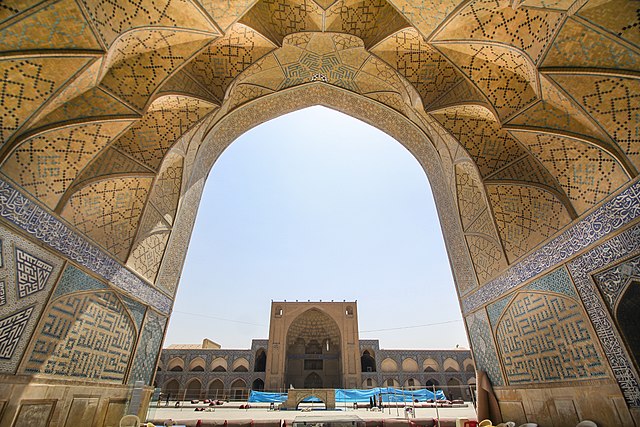
For the ultimate Jameh Mosque of Isfahan experience, springtime reigns supreme. Imagine wandering through its grand arches and ornate courtyards with the perfect weather—warm nights and not-too-hot days. Spring brings a lovely scent of flowers in the air, adding to the charm. But come mid-June, Isfahan heats up, making city visits less enjoyable. So, for the best trip, aim for the refreshing days of spring.
Working Hours of Jameh Mosque of Isfahan
Jameh Mosque of Isfahan is open every day from 9:00 am to 12:00 pm, and again from 2:00 pm to 4:30 pm. To beat the crowds and the midday heat, it’s best to visit in the morning. Just remember, the mosque closes for the afternoon prayer at noon, so plan your visit accordingly.
As you explore its beautiful architecture and peaceful courtyards, you’ll find yourself immersed in a journey through time and spirituality. From stunning mosaics to serene reflection pools, every corner tells a story waiting to be discovered. So, take your time and soak in the beauty of Jameh Mosque or Masjid-e Jameh of Isfahan during your morning visit.
Where to Eat Near Jameh Mosque of Isfahan
Azadegan Cafe
Enter Azadegan Cafe and find a place where good looks meet good food. The restaurant’s nice decorations make it a pleasant spot to enjoy some truly fresh and real dishes. From colorful salads to tasty stews, every meal here shows off the flavors of Iran.
Peace Coffee & Tea
For a taste of Turkish goodness in Isfahan, Peace Coffee & Tea is your go-to spot. People love it for its amazing Turkish coffee and cozy vibe. Whether you’re sipping coffee or tea, this place is sure to make you feel right at home.
Ghasr Monshi Restaurant
At Ghasr Monshi Restaurant, one of the best restaurants in Isfahan, you’re in for a treat. The place is not just great; it’s also known for its delicious food and friendly staff. From the moment you walk in, you’ll feel the warmth of their hospitality. With tasty Persian dishes and welcoming smiles, it’s a place you won’t forget.
Where to Stay Near Jameh Mosque of Isfahan
Iravani’s Historic House
Nestled in the heart of Isfahan’s ancient city, Iravani’s Historic House is a centuries-old architectural wonder. Built during the Qajar era in the early 1800s, it stands proudly next to the Jame Mosque, a symbol of Iran’s rich history. Recognized as a national treasure, this old monument showcases Persian craftsmanship at its finest.
Sarhang Palace Hotel
Sarhang Palace Hotel is a favorite among travelers exploring Esfahan. With its friendly staff and spotless facilities, it’s a cozy retreat after a day of sightseeing. Guests love the traditional charm of the rooms, which offer a peaceful escape in the midst of the city’s hustle and bustle.
Shahsavaran Mansion Boutique Hotel
A delightful stay awaits at Shahsavaran Mansion Boutique Hotel, where Iranian culture meets modern comfort. Located downtown, it’s a convenient base for exploring historical sites. The rooms are beautifully adorned with Iranian design elements, offering a cozy atmosphere with a touch of elegance. Guests praise the polite and helpful staff, ensuring a memorable experience throughout their stay.
Other Attractions Near Jameh Mosque of Isfahan
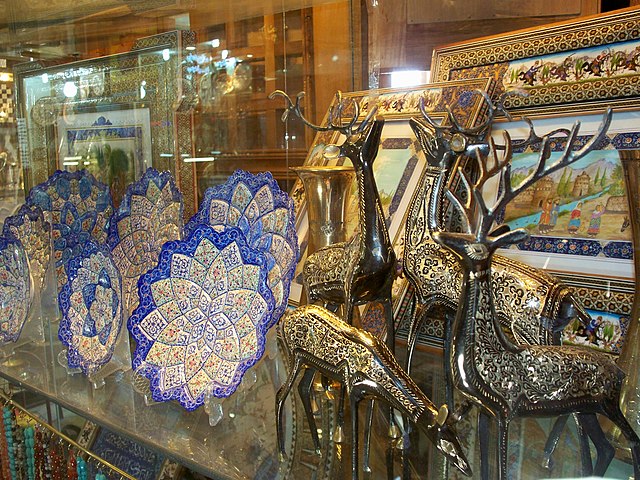
Grand Bazaar
Next to Jameh Mosque lies Isfahan Grand Bazaar, a lively marketplace filled with all kinds of goods. Nearby, you’ll also spot old-fashioned hotels called caravansaries, cozy restaurants, and traditional bathhouses. Back in the day, the mosque wasn’t just for prayers; it was the heart of the community. During wars, it became a meeting place for soldiers. When sickness struck, it turned into a makeshift hospital. And in tough times, it was a spot for sharing food among neighbors.
Caravansaries
Beside the Grand Bazaar are caravansaries, like ancient roadside inns. They were crucial for travelers on old trade routes, offering rest, food, and a chance to connect with fellow journeyers. Today, these caravansaries stand as reminders of history, showcasing the stories of merchants and travelers from centuries past. They add another layer of richness to the area around Jameh Mosque, inviting visitors to delve into the area’s fascinating past.
FAQs about Jameh Mosque of Isfahan
Q1: Why is the Jameh Mosque of Isfahan important?
A1: The Masjed-e Jāme’ of Isfahan is a great example of how people used new ideas and technology to improve an old mosque. It was originally built during the Seljuq period, then made bigger and better in later Islamic times with some top-notch additions.
Q2: What is the architecture of the Jameh Mosque?
A2: The mosque was constructed using mud-brick and adorned with stucco decorations, following the style of Abbasid architecture from the Syro-Mesopotamian region. In the 1970s, while studying the mosque that stands today, archaeologists uncovered the remains of this earlier mosque. Around 840-841, during the rule of Al-Mu’tasim, a larger mosque was built, replacing the original one.
Q3: Who built the Isfahan mosque?
A3: The main sanctuary was constructed under the guidance of Niẓām al-Mulk, who was the vizier to the Seljuq ruler Malik-Shāh, around 1070 to 1075. It’s located at the southern part of the courtyard. This sanctuary has a big dome made of bricks, which is held up by 12 strong pillars.
Q4: What is the best Persian mosque?
A4: The Shah Mosque, also known as Masjed-e Shah in Persian, is situated in Isfahan, Iran. Positioned on the southern edge of Naghsh-e Jahan Square, it was commissioned by Shah Abbas I of Persia during the Safavid dynasty. This mosque is celebrated as one of the finest examples of Persian architecture from the Islamic period.
Q5: What is unique about the Great Mosque of Isfahan?
A5: The mosque serves as a visual record, reflecting both the political needs and artistic preferences of the powerful Islamic empires of Persia. Additionally, its notable feature is how it blends into the cityscape. Situated in the heart of the old city, the mosque is connected to surrounding buildings, sharing walls with them along its edges.
Last Words: Experience the Best of Jameh Mosque of Isfahan with a Customized Tour
The Jameh Mosque of Isfahan, also called Isfahan Old Friday Mosque, is an ancient mosque in Isfahan city. It’s been around since the 8th century and has been rebuilt many times. It’s really important—it’s a UNESCO World Heritage Site! Some people think one of its pillars might have been made by a powerful leader long ago. Before it was a mosque, it was a place of worship for a different religion called Zoroastrianism.
If you’re dreaming of exploring Iran’s magnificent Jameh Mosque of Isfahan and want to make the most of your trip, consider a customized tour. Meet To Iran Tour – your go-to for exceptional Iran tours. We specialize in crafting unique itineraries that showcase Iran’s diverse beauty and culture. With our experienced team, we’ll create a travel plan that perfectly fits your desires, whether you’re into history, architecture, or soaking up local culture.
Let To Iran Tour be your partner in creating the perfect travel experience in Iran.

